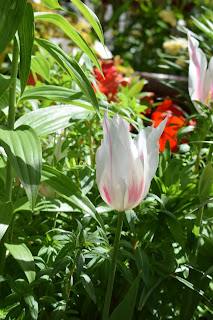Given the dry month we're having, I'm afraid we will have to supply the 'showers' that will bring May flowers to our gardens. I want to mention, mostly because watering is rarely a topic that comes up, that there is an art to watering, if not a science. It's a big topic but here are 4 key points. 1. Over-watering can be harmful to plants, not to mention wasting a valuable resource. 2. Plants in pots, outside of succulents, are always going to need some regular water, their root systems being contained. 3. Mulching can cut down on the amount of water you use more than any other single thing you do. 4. While most native plants are drought tolerant - we do after all live in a summer dry climate - not every single native can make do with very little precip. If you do not have an irrigation system and are watering by hand, it behooves us all to water only the areas underneath each plant and not the rest of the ground. Besides, stray water = weeds!
Okay, here are today's garden photos.
Most people are familiar with the Bottlebrush tree and its bright red flowers. Here is a species that has green flowers! As many of you know, green flowers are uncommon in the world of plants so this Callistemon pachyphyllus is a real treat.
Here is the middle of my three densely planted median strips. This one is dominated by an ever flowering Anisodontea and a Smoke bush.
Here is the eastern of the 3 median strips. This one features a Magnolia Butterflies and an exuberant Lonicera x americana (honeysuckle).
I have one main front yard bed and this is it. i call it the Sun King bed, a Beatles reference that reflects the sunny location and all the great stuff I can grow there.
At the corner of the Sun King bed is this Leucospermum Veldfire. My neighbor and I both have floriferous varieties in our front yards.
Dutch iris Bronze Blend. This mix includes nice combos of gold, ginger and redwood colors.
Gladiolus nanus mix. This species mix includes several kinds of species glads. I'm not sure what this beauty is, though it's similar to G. tristis.
I had a good crop of Douglas iris this year. They finally has begun to naturalize in earnest.
Leptospermum salignum. This tea tree finally produced its first flowers, after a wait of five years!
Exbury azalea Red. The Exburys are deciduous azaleas that feature reds, oranges and golds.
Here's another shot of my middle median strip, more clearly showing the burgundy leaves of the Cotinus Royal Purple.
Aloe striata. This aloe has become a blooming machine and the hummers love it.
It took forever for the 'buttons' on my Berzelia lanuginosa to open up to white flowers. Honestly, it's not much of a change but it's still a lovely shrub.
Ornithogalum Drooping Star. This S. African bulb features otherworldly grayish-white flowers.
Trachelospermum asiaticum. This slow growing tri-colored jasmine is grown for its lovely leaf colors.
Though it hasn't filled out yet, this Physocarpus 'Monlo' has some of the darkest foliage of any ninebark.
Everybody's favorite bellflower - Campanula Blue Waterfall.
Pelargonium Caroline's Citrine. An unusual shade-loving pelargonium that gets big in a hurry!
Fallopia japonica variegata. Very, very white!














































